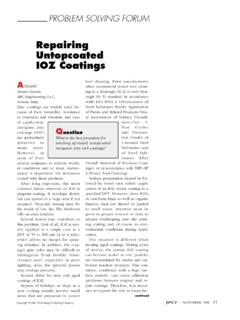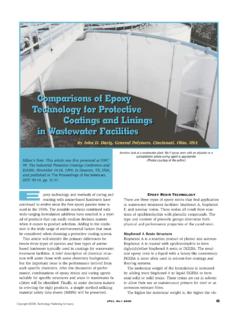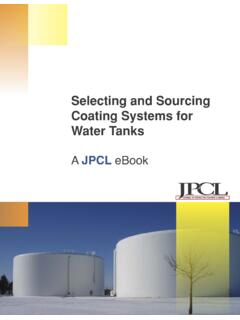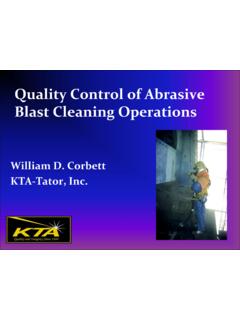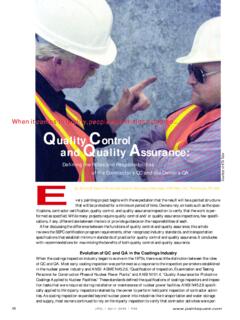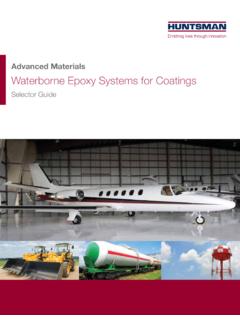Transcription of PAINTSQUARE.COM JOURNAL OF PROTECTIVE COATINGS & …
1 RAILCAR INDUSTRY COATINGSYSTEMS: SELECTING ANDSOURCINGA JOURNAL OF PROTECTIVE COATINGS & LININGSiRailcar Industry CoatingSystems: Selecting andSourcingA JPCLeBookCopyright 2013 byTechnology Publishing Company2100 Wharton Street, Suite 310 Pittsburgh, PA 15203 All Rights ReservedThis eBook may not be copied or redistributed without the written permission of the Crude Truth about Lining Tanks for Oil Transportby Michael McGlamry, Hempel USAC oating System Guide for the Railcar IndustryCoating Company ProfilesContentsiiSPONSORED eBook consists of a feature published in the JOURNAL ofProtective COATINGS & Linings(JPCL) on protecting railcars foroil service, as well as JPCLB uying Guide material on selectingand specifying COATINGS for railcar applications in various exposure Buying Guide is organized by various exposure types,such as Linings for Steel Railcar Interiors, Bulk Solids.
2 Then,coating manufacturers are listed in alphabetical order, witheach company s preferred system named in both proprietaryand generic terms. Finally, contact details are given for all collection is designed to provide general guidance on selecting and specifying COATINGS for railcars, and then to givesources for acquiring the appropriate systems. Information inthis eBook is based on the original dates of publication of the ockphoto1 Editor s Note:This article appeared inJPCLin September Michael McGlamry,Hampel USAThe Crude Truth about Lining Tanks forOil TransportPhoto courtesy ofHempel USAIn the past, tank cars carrying crude oilhad no PROTECTIVE linings for corrosionprotection. Cargoes of light sweet crude(containing less than sulfur) have a passi-vating effect on the steel of the cars, and verylittle corrosion was ever identified during rou-tine inspections.
3 Why is there now significantconcern about corrosion in rail cars, when theindustry has a track record (pun intended) ofover 100 years with very low corrosion ratesin unlined cars? What has changed? Is crude be-coming more corrosive? Are fracking chemicalsmixing with the oil and corroding our steel?Before we answer these questions, let s con-sider some numbers about the rail business con-cerning crude shipments from a May 2013report from the Association of American Rail-roads: The 2013 report noted that whereas fiveyears ago (2008), Class I railroads origi-nated just 9,500 carloads of crude oil, 1thenumber of carloads originated had increased to234,000 in 2012, and in the first quarter of2013, the number was 97,000. Given the 2013first quarter number, the report predicted an-other large increase in carloads of crude origi-nated by Class I the above numbers, maybe we are see-ing more corrosion on tanker cars just becausewe have a whole lot more steel exposed.
4 Ormaybe we are carrying crude that s not onlycrude. The answer to our problem can be foundby understanding oil production and the con-2stituents in crude. For this discussion, we arefocusing on the developments in the unconven-tional onshore oil market in North America,which is pushing the overall rail crude oil tankrequirement must understand that there are severaladvanced completion techniques within the un-conventional market, including, to name a few,traditional welling/fracking, in situ mining,steam-assisted gravity drainage (SAGD), andcyclic steam stimulation (CSS). For this article,we will focus specifically on the fracking com-pletion has been a lot of discussion in the un-conventional oil and gas market and in themedia about fracking, so we won t go into greatdetail here, but the fact is, there are corrosivechemicals used in the fracking presence of corrosive chemicals in frack-ing raises a question about transporting oil:When those chemicals are pumped into the for-mation, do they return to the surface with theoil extracted and with enough corrosion poten-tial to cause problems?
5 The answer is No. While the chemicals can be found in the pro-duced crude, the concentrations are so low thatthey are not seen as problematic. It s importantto note that with traditional extraction meth-ods, crude oil also contains water, chlorides,oxygen, and up to sulfur for sweet crudeor higher for sour about bitumen produced from miningoil sands? Oil sands are a naturally occurringmixture that typically contains 10 12% bitu-men, 80 85% minerals (clays and sands), and4 6% water. Bitumen is a mixture of large hy-drocarbon molecules containing sulfur com-pounds (equivalent to up to 5% elemental sulfurby weight), small amounts of oxygen, heavymetals, and other that we are starting to get a clear pictureof the composition of the cargo, we should takea closer look at the water, sulfur, and we do, the ah-hah moment comes.
6 Bi-tumen is extremely viscous at ambient temper-atures, but crude can be just as viscous in ex-tremely cold temperatures, such as thoseoccurring in North Dakota winters. In an effortto make the bitumen or crude flow into the tankcars, it is heated. This heating causes the water,sometimes with high levels of chloride, to natu-rally separate from the oil and sink to the heel,or bottom, of the rail car. So, we ve created anenvironment that contains sulfur, high chloridelevels, and hot water, an environment ideal forsupporting corrosion. To put this environmentinto perspective, even at ambient temperatures,wet elemental sulfur has been shown to corrodemild steel up to 1 mm/yr ( ), with lo-calized pitting rates of up to 7 mm/yr ( ). With the addition of chlorides, thecorrosion rates have been shown to double andeven triple, in research conducted by Fang,Young, and Ne i.
7 2 Now that we have a better idea of what we refighting, another question arises: How do weprotect the interiors of tank cars carrying crudeoil or bitumen from oil sands? We ll need an in-terior lining that must be resistant to high tem-peratures, and, since high-pressure steam isoften used during the cleaning of the tank cars,with steam temperatures that can be as high as330 F (166 C), the lining also must be resistantto thermal shock. In addition, during crude load-ing in the winter, the steel temperature could be-40 F (-40 C), while the crude temperature willbe around 160 F (71 C). This condition leads toan immediate 200-degree F (111-degree C) tem-perature swing, resulting in thermal expansionof the steel as well as the lining material. So thelining will also need to have some level of flex-ibility to cope with the flexing of the tank carduring loading and unloading operations, aswell as the general movement associated withtransportation.
8 This is a tall order, even beforeadding the chemical resistance requirements ofhot chloride water and the low pH environmentassociated with sulfur good news is that advanced technologyphenolics and thick-film epoxy novolac liningson the market can withstand the manufacturers focused on the rail in-dustry have long, successful track records forthis type of service. The real question becomes,should you risk an unscheduled release and lossof an asset because the tank car wasn t lined?References1. Association of American Railroads, MovingCrude Oil by Rail, May 2013, Haitau Fang, David Young, and Srdjan Ne i , Elemental Sulfur Corrosion of Mild Steel atHigh Concentrations of Sodium Chloride, 17thInternational Corrosion Congress, Paper#2592, Las Vegas, NV, October 6 10, the authorMichael McGlamry is theAmericas PROTECTIVE Prod-uct Manager for Hempel,USA.
9 McGlamry is highlyexperienced in the coat-ings world, with almost 20years in the PROTECTIVE andLining Segments. He hasworked in a variety ofroles including Product Manager, Lining TechnicalManager, Technical Service Manager, and Up-stream Offshore Engineering Sales. He is NACEL evel 1 certified and also holds an internationalcertification for Project IndustriesIronBond 111 Inorganic zinc /Epoxy/UrethaneArma CoatingsArma Polyaspartic Spray PolyureaPolyurea Pure (1, 2, or 3 Coats)Bowers IndustrialGulf Coast PaintEpoxy (1-2 Coats)/UrethaneCarboline CompanyCarbothaneEpoxy (1-2 Coats)/UrethaneCorrocoat USA ZipcoatPolyester/Polyester/PolyesterCorr osealCorroseal Rust ConverterOtherCortec CorporationVpCI-384/382 Urethane/UrethaneCote-L Industries 18/Durabak 18 SmoothUrethane/UrethaneCSL Silicones 531 Siloxane/SiloxaneFSC COATINGS Silicone Poly PlusEpoxy (1-2 Coats)/UrethaneGlobal EcoTechnologiesEndura-FlexUrethane Elastomeric (1 Coat)
10 HJ3 Composite TechnologiesHJ3 CarbonSeal Industrial SystemsEpoxy/Epoxy Novolac (2 Coats)Industrial Nanotech High HeatThermal SprayITW Polymers COATINGS North AmericaAS-250 Epoxy/Epoxy/EpoxyJotun Paints zinc /Epoxy/UrethaneKCC Corrosion Control Co., UR-5 Urethane/UrethaneOak Ridge Chemical and EquipmentOak RidgePolyurea Pure (1, 2, or 3 Coats)Peerless Industrial SystemsEpigenEpoxy 100% Solids (1 or 2 Coats)Polibrid COATINGS , 705 Urethane Elastomeric (1 Coat)Premier Coating Systems #1100/PCS-#4300 OtherRhino Linings CorporationRhino SolarMaxPolyurea Hybrid (1, 2, or 3 Coats)Rodda Paint PaintClovaPrime 21/Armourshield XPEpoxy (1-2 Coats)/UrethaneRoval USA R22 Cold Galvanizing CompoundZinc-Rich, OrganicRust Bullet, LLCRust Bullet StandardOtherSauereisen, 100% Solids (1 or 2 Coats)Sherwin-WilliamsMacropoxy 646-100/Hi-Solids Polyurethane 100 Epoxy (1-2 Coats)/UrethaneSpecialty Products, Inc.
